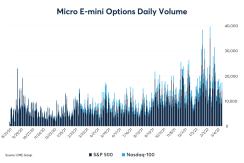By Paul Golden, for CME Group
AT A GLANCE
- Micro E-mini equity options are tapping into industry demand for equity index products that are suitable for a wider range of investors
- More options trading in 2021 coincided with a rise in investor education
The trend extended to stock options, where retail investors accounted for more than 25% of total options trading activity, according to one study. One of the clearest examples of the growing popularity of options, however, rests in the futures market.
Micro E-mini equity options took off in 2021. In the time period between introduction of this product in August 2020 and the end of 2021, more than three million Micro E-mini option contracts were traded by those keen to expand the range of tools at their disposal for equity index trading.
Traders have shown enthusiasm for both Micro E-mini S&P 500 and Nasdaq-100 options on futures contracts, with average daily volume exceeding 10,000 contracts over the course of 2021.
More Accessible Options
The idea behind the launch of Micro E-mini equity options was to have a product that enabled precision trading for both institutions looking to fine-tune strategies as well as smaller investors looking to risk-manage exposures with lower capital outlay per trade, says Brian Burke, Senior Director of Equity Index Products at CME Group.Micro E-mini equity option contracts are 1/10th the size of the long-standing E-mini equity index options. Micro E-mini options allow for more precision by offering 10 contract expiries at any given time -- five weeklies, three end-of-month, and two quarterly contracts – that allow traders to express long or short-term views. Their futures counterpart launched in 2019 and has since traded more than one billion contracts.

“The rally in the market over the last few years means contract sizes are bigger than they used to be,” explains Burke. “The $5 multiplier option for Micro E-mini S&P 500 options on futures, for instance, is more accessible for investors looking to express a market view with as little as $1,000 to trade these popular indices.”
The product is an important element of the industry-wide drive to make equities more accessible, another instance of which is equities platforms that allow investors to buy small fractions of individual stocks. Similarly, Micro E-mini options offer the same lower threshold for access while also offering additional benefits.
“These options offer clear benefits for traders looking to risk-manage higher priced Nasdaq-100 constituents with low capital outlay; Micro E-mini Nasdaq-100 options on futures give traders diversification, accessibility, and capital efficiency to hedge tech exposures. It’s a very unique value proposition,” says Burke.
Customizing Strategy
JB Mackenzie is Charles Schwab’s managing director for futures & forex. He observes that the firm has seen continued growth in interest from its retail investors in futures products.“The advantage of using products like Micro E-mini equity options on futures products is that they are available 24 hours a day and can be accessed as soon as news that impacts the markets breaks,” he explains.
The ability to access smaller-sized options on the suite of Micro E-minis – available on the S&P 500, and Nasdaq-100 – allows retail investors to customize their risk defined strategies based on the size of their portfolios, adds Mackenzie.
Many transactions in Micro E-mini equity options are made by traders with smaller capital allocations per strategy, or retail traders looking to trade market developments such as the 2021 tech stock boom, or macro trends like rising inflation. On February 11, micro options in Nasdaq 100 and S&P 500 combined to trade nearly 40,000 contracts, a single day record, as the Consumer Price Index, the key measure of inflation in the U.S., reached a 40-year high of 7.5%.
Burke says that while retail investors have been particularly enthusiastic about the product, he notes that CME Group has designed it to appeal to the institutional market also.
“We have had some interesting conversations with larger entities because they tend to be pretty satisfied with the E-mini S&P 500 option, which has a $50 dollar multiplier,” he says. “However, many have seen the benefit of using this product to fine-tune their strategy or tweak their approach with a high degree of precision.”
Mackenzie says the availability of Micro E-mini equity products coupled with investor education - has given Schwab clients another financial tool to utilize in managing their portfolios.
“We have seen a very high level of client engagement with Micro E-Mini options products, with volumes up by more than 300% over the last 12 months,” he adds.
While retail investors always had the ability to access E-mini index options products, the introduction of Micro E-Mini options provided them with a smaller sized contract that can deliver even more flexibility to scale into equity index exposure or more precisely hedge their existing equity positions.
More Education, More Confidence
While describing Micro E-mini equity options as the most efficient low-cost mechanism for accessing these markets, Burke adds that while there can be a learning curve for futures and options, the benefits in terms of accessibility, flexibility and cost savings are significant. “Some investors are not familiar with all of the benefits of this type of product, so we find that many early adopters are more sophisticated retail investors,” he says.This point is taken up by Mackenzie, who describes 2020 as a standout period for investor education. With the vast number of clients working from home during the early stages of the pandemic, TD Ameritrade noticed a significant increase in the use of its investor education offerings, which largely continued through 2021. TD Ameritrade was acquired by Charles Schwab in 2020.
The firm has also observed that those clients utilizing its investor education resources and the TD Ameritrade Network have become more confident about following sophisticated strategies such as micro options.
“We continue to see investor engagement with these products around specific market events such as earnings announcements to hedge exposure, but also when unexpected market volatility occurs,” adds Mackenzie.
Read more articles like this at OpenMarkets






